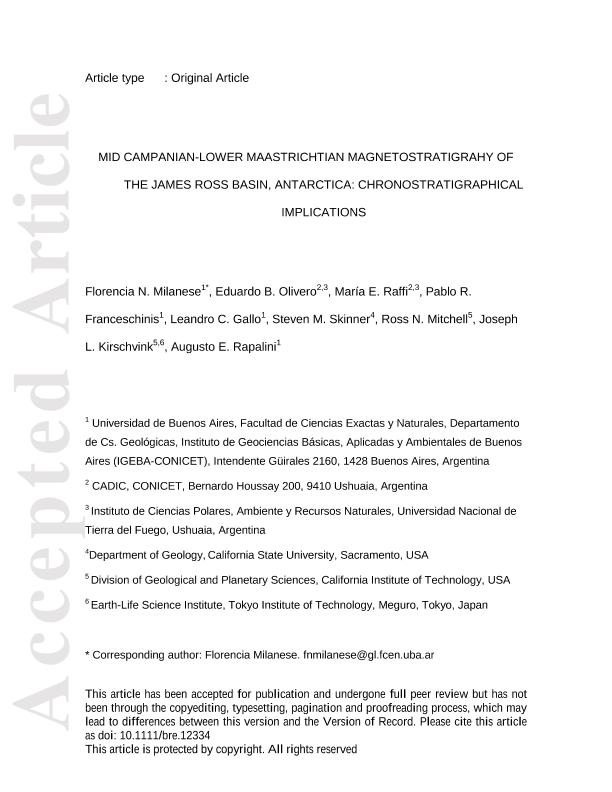Artículo
Mid Campanian-Lower Maastrichtian magnetostratigraphy of the James Ross Basin, Antarctica: Chronostratigraphical implications
Milanese, Florencia Nidia ; Olivero, Eduardo Bernardo
; Olivero, Eduardo Bernardo ; Raffi, María Eugenia
; Raffi, María Eugenia ; Franceschinis, Pablo Reinaldo
; Franceschinis, Pablo Reinaldo ; Gallo, Leandro César
; Gallo, Leandro César ; Skinner, Steven M.; Mitchell, Ross N.; Kirschvink, Joseph L.; Rapalini, Augusto Ernesto
; Skinner, Steven M.; Mitchell, Ross N.; Kirschvink, Joseph L.; Rapalini, Augusto Ernesto
 ; Olivero, Eduardo Bernardo
; Olivero, Eduardo Bernardo ; Raffi, María Eugenia
; Raffi, María Eugenia ; Franceschinis, Pablo Reinaldo
; Franceschinis, Pablo Reinaldo ; Gallo, Leandro César
; Gallo, Leandro César ; Skinner, Steven M.; Mitchell, Ross N.; Kirschvink, Joseph L.; Rapalini, Augusto Ernesto
; Skinner, Steven M.; Mitchell, Ross N.; Kirschvink, Joseph L.; Rapalini, Augusto Ernesto
Fecha de publicación:
06/2019
Editorial:
Wiley Blackwell Publishing, Inc
Revista:
Basin Research
ISSN:
0950-091X
Idioma:
Inglés
Tipo de recurso:
Artículo publicado
Clasificación temática:
Resumen
The James Ross Basin, in the northern Antarctic Peninsula, exposes which is probably the world thickest and most complete Late Cretaceous sedimentary succession of southern high latitudes. Despite its very good exposures and varied and abundant fossil fauna, precise chronological determination of its infill is still lacking. We report results from a magnetostratigraphic study on shelfal sedimentary rocks of the Marambio Group, southeastern James Ross Basin, Antarctica. The succession studied covers a ~1,200 m-thick stratigraphic interval within the Hamilton Point, Sanctuary Cliffs and Karlsen Cliffs Members of the Snow Hill Island Formation, the Haslum Crag Formation, and the lower López de Bertodano Formation. The basic chronological reference framework is given by ammonite assemblages, which indicate a Late Campanian – Early Maastrichtian age for the studied units. Magnetostratigraphic samples were obtained from five partial sections located on James Ross and Snow Hill islands, the results from which agree partially with this previous biostratigraphical framework. Seven geomagnetic polarity reversals are identified in this work, allowing to identify the Chron C32/C33 boundary in Ammonite Assemblage 8-1, confirming the Late Campanian age of the Hamilton Point Member. However, the identification of the Chron C32/C31 boundary in Ammonite Assemblage 8-2 assigns the base of the Sanctuary Cliffs Member to the early Maastrichtian, which differs from the Late Campanian age previously assigned by ammonite biostratigraphy. This magnetostratigraphy spans ~14 Ma of sedimentary succession and together with previous partial magnetostratigraphies on Early-Mid Campanian and Middle Maastrichtian to Danian columns permits a complete and continuous record of the Late Cretaceous distal deposits of the James Ross Basin. This provides the required chronological resolution to solve the intra-basin and global correlation problems of the Late Cretaceous in the Southern Hemisphere in general and in the Weddellian province in particular, given by endemism and diachronic extinctions on invertebrate fossils, including ammonites. The new chronostratigraphic scheme allowed us to calculate sediment accumulation rates for almost the entire Late Cretaceous infill of the distal James Ross Basin (the Marambio Group), showing a monotonous accumulation for more than 8 Myr during the upper Campanian and a dramatic increase during the early Maastrichtian, controlled by tectonic and/or eustatic causes.
Palabras clave:
ANTARCTIC PENINSULA
,
MARAMBIO GROUP
,
PALAEOMAGNETISM
,
UPPER CRETACEOUS
Archivos asociados
Licencia
Identificadores
Colecciones
Articulos(CADIC)
Articulos de CENTRO AUSTRAL DE INVESTIGACIONES CIENTIFICAS
Articulos de CENTRO AUSTRAL DE INVESTIGACIONES CIENTIFICAS
Articulos(IGEBA)
Articulos de INSTITUTO DE GEOCIENCIAS BASICAS, APLICADAS Y AMBIENTALES DE BS. AS
Articulos de INSTITUTO DE GEOCIENCIAS BASICAS, APLICADAS Y AMBIENTALES DE BS. AS
Citación
Milanese, Florencia Nidia; Olivero, Eduardo Bernardo; Raffi, María Eugenia; Franceschinis, Pablo Reinaldo; Gallo, Leandro César; et al.; Mid Campanian-Lower Maastrichtian magnetostratigraphy of the James Ross Basin, Antarctica: Chronostratigraphical implications; Wiley Blackwell Publishing, Inc; Basin Research; 31; 3; 6-2019; 562-583
Compartir
Altmétricas



